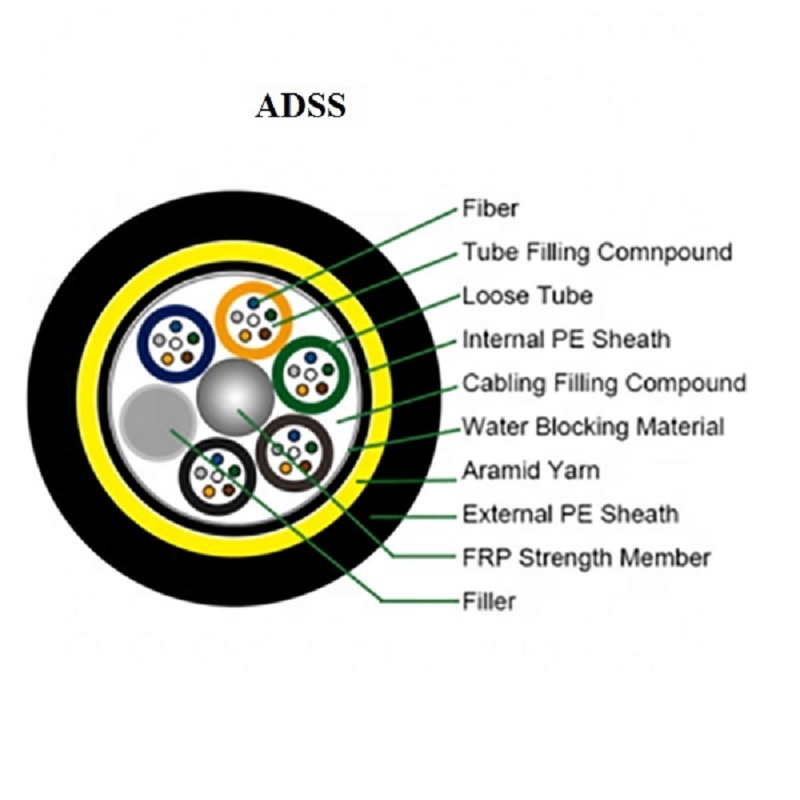Fiber Optic ADSS Cable is known as an all-dielectric self-supporting optical cable. Self-supporting ensures that the ADSS fiber optic cable has sufficient mechanical strength. The ADSS fiber cable applies all-dielectric material to withstand the impact of strong electricity in a high voltage and strong current environment. As one of the most professional ADSS cable suppliers and manufacturers, TUOLIMA can customize the self-supporting fiber optic cable ADSS according to your requirements. If you need any technical support, we will also recommend the most suitable and cost-effective customized ADSS OFC cable for you according to the different application environments, laying methods, and customer requirements. Our all-dielectric self-supporting cables can be applied in many areas, for example, the aerial industry. You can check ADSS fiber specs below. If you have any questions, please feel free to contact us.
Mechanical characteristic and test method | |||
Tensile strength | conform to IEEEC standard P 1222---1995 | ||
Crush | conform to IEC 794-1-E3 | ||
Impact | conform to IEC 794-1-E4 | ||
Repeated bending | conform to IEC 794-1-E6 | ||
Torsion | conform to IEC 794-1-E7 | ||
Flexing | conform to IEC 794-1-E8 | ||
Cable bend | conform to IEC 794-1-E11 | ||
Water penetration | conform to IEC 794-1-F5B | ||
Color coding | conform to EIA/TIA 598 | ||
Temperature requirement | operation: Installation | - 40 C~ +60 C - 10 C ~ +60 C | |
storage/transportation | - 40 C ~ +60 C | ||
Temperature cycling test | conform to IEC 794-1-F1 | ||
Bending Radius | unloaded | 15 times of outer diameter | |
loaded | 25 times of outer diameter | ||
Fiber Material | G652D |
Mode field diameter (1310nm): | 9.2um±0.4um |
Mode field diameter (1550nm): | 10.4um±0.8um |
Cladding diameter: | 125um±1.0um |
Cut off wavelength of cabled fiber (ℷcc): | ≤1260nm |
Attenuation at 1310nm: | ≤0.36dB/km |
Attenuation at 1550nm: | ≤0.22dB/km |
Bending loss at 1550nm (100 turns, 30mm radius): | ≤0.05dB |
Dispersion in the range 1288 to 1339nm: | ≤3.5ps/(nm•km) |
Dispersion at 1550nm: | ≤18ps/(nm•km) |
Dispersion slope at zero dispersion wavelength: | ≤0.092ps/(nm2•km) |
SN | Item | Unit | Value |
1 | No. of fibers | count | 12~288 |
2 | Number of fibers per tube(max) | count | 4 |
3 | Number of elements | count | 6 |
4 | Cable diameter | mm | 12.1 |
5 | Cable weight | kg/km | 121 |
6 | Max allowed operating tension | N | 5000 |
7 | Short term crush | N/100mm | 2200 |
8 | Max span with 1.0% installation sag | m | 100 |

Uninterruptible power supply erection
Adopt PE/AT sheath, excellent resistance to erosion
Small cable diameter and lightweight help reduce the impact of ice, wind, and load on towers
Large span, maximum span ≥ 1000 meters
Great tensile strength and high/low temperature resistance
Service life is expected over 30 years
Packing material: Non-returnable wooden drum.
Both ends of the outdoor optical cable are securely fastened to the drum and sealed with a shrinkable cap to prevent ingress of moisture.
Cable printing: The sequential number of the cable length shall be marked on the outer sheath of the cable at an interval of 1meter ± 1%.
The following information shall be marked on the outer sheath of the cable at an interval of about 1 meter.
1. Cable type and number of optical fiber
2. Manufacturer name
3. Month and Year of Manufacture
4. Cable length
Drum marking: Each side of every wooden drum shall be permanently marked in a minimum of 2.5~3 cm high lettering with the following:
1. Manufacture name and logo
2. Cable length
3. Fiber optic cable types and number of fibers
4. Rollway
5. Gross and net weight
Basically, the installation of ADSS optic cable is divided into two steps:
Step 1: Lay, arrange, and tighten the dielectric fiber optic cable and then install cable fittings and bridge molding.
Step 2: Fiber optic connection and characteristic test of the optic fiber.
The tips of ADSS fiber optic cable installation:
1. The diameter of the traction wheel shall not be less than 500mm, and the groove shall be semicircular, its depth shall be greater than the outer diameter of the optic cable, and the wheel groove shall be made of rubber or nylon.
2. When installing an ADSS fiber optic cable, the pulley must be reliably grounded.
The straight-line distance from the tower to the cable laying equipment shall be greater than 4 times the height of the pulley suspension point to reduce the side pressure on the optic cable. Excessive tension shall not be used to pull the optic cable during cable laying, and the traction force shall not be greater than half of the initial tension borne by the optic cable. The traction speed of the optic cable is generally not greater than 20m/min.
3. The welding of self-supporting fiber optic cable shall be completed on the same day after the wiring of each coil is completed.
4. The tail cable reel and connecting reel shall be fixed on the tower at a position not less than 6m from the ground.
5. During ADSS cable installation, the optic cables located in the working area and between the static end connecting fittings shall be reliably grounded.
6. In order to ensure the connection quality and reduce the construction cost, the construction period of ADSS optic cable should be carried out in spring and autumn when there is less rain and snow. If construction has to be carried out in cold winter, temporary tents shall be erected and the temperature shall reach more than 0℃.
Related Products